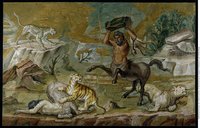Kunst am Kaiserhof:
Im Umkreis des Herrschers entstanden nicht nur die Vorbilder für die Porträttypen der kaiserlichen Familie, der Hof war auch stilbildend für die Mode. Außerdem förderten die Kaiser von Beginn an die Kunst und nutzten sie für ihre Repräsentation. Die Kameen, erhaben geschnittene Reliefbilder aus Edelstein, vor allem aus Lagenachat, sind als Luxusgattung besonders mit dem Herrscherhaus verbunden. Sie dienten vermutlich als diplomatische Geschenke und Repräsentationsstücke am Hof. Deshalb trugen sie Herrscherlob und Selbstverständnis, etwa durch Götterattribute, offensiver vor als dies in der öffentlich präsentierten Staatskunst möglich war. Viele der Stücke blieben in der kaiserlichen Schatzkammer und gerieten über Byzanz im Mittelalter als Fürstengeschenke zurück in den Westen und dann als Stiftungen in Kirchenbesitz.
Der aus kaiserlichen Steinbrüchen in Ägypten stammende rote Porphyr war wegen seiner königlichen Purpurfarbe seit dem späten 3. Jh. n. Chr. exklusiv dem Kaiserhaus vorbehalten – für Ausstattungsgegenstände, Bauglieder, Sarkophage oder Herrscherstatuen.
Art at the Imperial Court
Not only did the models for portrait types of the imperial family originate in the radius of the ruler, the court also set the style for fashion. In addition, the emperors advanced the arts right from the beginning and used them for their own representation. Cameos, raised relief images cut from precious stones, predominantly from layered agate, are especially connected with the ruling house as a special category of luxury. Presumably, they served as diplomatic gifts and representative pieces at court. Therefore, they advocated praise and self-image of the ruler, for instance via attributes of deities, more directly than was possible in publicly presented state art. Many of these cameos remained in the Imperial Treasury and returned to the West via Byzantium as princely gifts in the Middle Ages and then came into the possession of the Church by way of endowments.
Since the late 3rd century AD, the red porphyry from the imperial quarries in Egypt was exclusively reserved for the imperial dynasty due to its royal purple colour – for furnishings, building elements, sarcophagi or statues of rulers.
en

